


Framed or unframed, desk size to sofa size, printed by us in Arizona and Alabama since 2007. Explore now.
Shorpy is funded by you. Patreon contributors get an ad-free experience.
Learn more.

- Details, Details
- What's that building to the left of the tower?
- Coal Barges
- Bromo-Seltzer
- Inner harbor
- The Basin
- What a headache!
- Giant stepladder?
- Baldwin 62303
- Baldwin VO-1000
- Cold
- No expense spared
- Tough Guys
- Lost in Toyland
- And without gloves
- If I were a blindfolded time traveler
- Smoke Consumer Also Cooks
- Oh that stove!
- Possibly still there?
- What?!?
- $100 Reward
- Freeze Frame
- Texas Flyer wanted
- Just a Year Too Soon
- WWII -- Replacing men with women at the railroad crossing.
- Yes, Icing
- You kids drive me nuts!
- NOT An Easy Job
- I wonder
- Just add window boxes
Print Emporium
Horsecar Opera: 1890
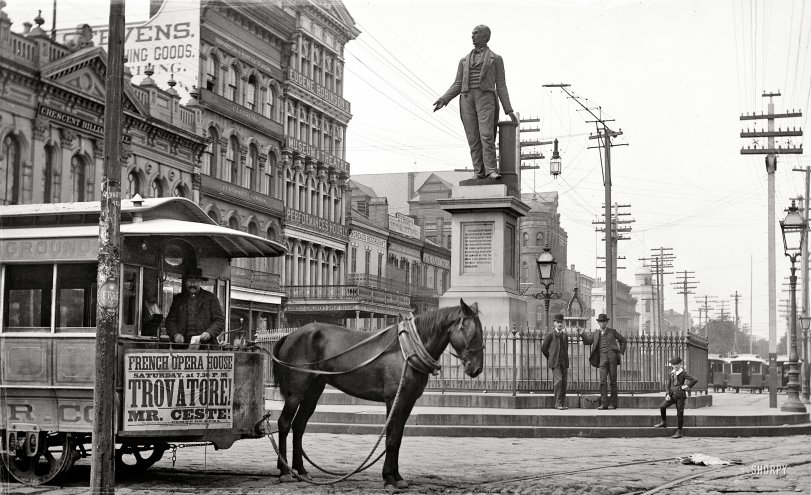
New Orleans circa 1890. "The Clay Monument, Canal Street." Fascinating details abound in this scene captured by William Henry Jackson: The 1-horsepower horsecar, the ancient carbon-arc lamp suspended from a complicated-looking boom, and much signage. Personal favorites: WIG MANUFACTORY, and logo of the ETV&G (East Tennessee, Virginia and Georgia) Railway. View full size.
Eugene Robinson's Museum & Theatre
Note the 5 story building at 714 Canal (since the 1894 street address renumbering), in the photo housing "Eugene Robinson's Museum & Theatre". I worked in that building in the 1980s when the bottom 3 floors housed a book store. Eugene Robinson's story is more interesting than mine, however. He was something of a P.T.Barnum wanna-be with rather dubious exhibits in his dime museum, but also a patron of the arts - at least as far as realizing that hiring a loud band was a good way to draw a crowd. The attached image appeared in a weekly scandal sheet, "The Mascot", for 15 November, 1890. The late New Orleans writer Al Rose claimed it was the earliest known illustration of a New Orleans jazz band. Apparently not everyone was a fan of the new style of music.
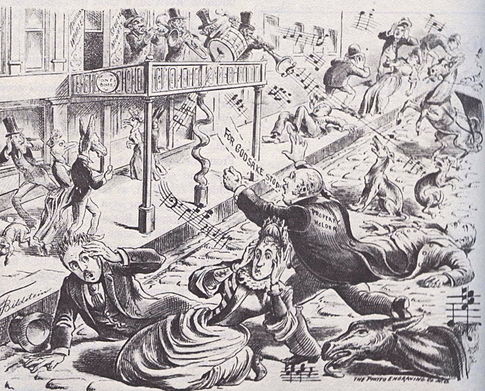
Inscription
The inscription on the Clay statue reads
"IF I COULD BE INSTRUMENTAL IN ERADICATING THIS DEEPEST STAIN, SLAVERY, FROM THE CHARACTER OF OUR COUNTRY I WOULD NOT EXCHANGE THE PROUD SATISFACTION WHICH I SHOULD ENJOY FOR THE HONOR OF ALL THE TRIUMPHS EVER DECREED TO THE MOST SUCCESSFUL CONQUEROR"
This might seem odd for a statue erected in New Orleans most prominent intersection in 1856. The inscription, however, was added during the Civil War occupation by Union General Banks who dredged the quotation from a speech made by Clay in 1827 to the American Colonization Society, which was advocating resettlement of slaves to Africa.
Apparently, Banks was inspired by his predecessor, General Butler, who had added "The Union must and shall be preserved" to the Jackson statue in Jackson square.
I think the Jackson inscription remains, but when the Clay statue was moved to Lafayette square in 1900, the new base was only inscribed with a innocuous statement about the date and place of the original installation and the date of the move.
Trovatore ou Le Trouvère?
It seems likely that Mr. Cesta, as he is billed as singing the "Comte de Luna" rather than "Conte di Luna," is participating in a performance of the French version of Verdi's opera, Le Trouvère. It was definitely in the repertoire at both the French Opera House as well as the older Théâtre d’Orléans; in fact, the French Opera Company brought the production to New York's Lyric Theatre in April, 1912. Verdi himself reworked Il Trovatore for the Paris Opera in 1856 to meet the house's requirement that operas be performed in French. Another stipulation was that there be a ballet and, unlike those he wrote for the other French versions of his operas, Verdi's 20-minute work includes themes from the opera itself. One wonders if this was also part of the New Orleans production.
Yes, It was moved to Lafayette Square
It was moved ostensibly because of traffic considerations, but many times in its history it had been the rallying point for white mobs and Confederate sympathizers. It is believed that the real reason for the move was to prevent further violence.
It was moved in 1901.
Mr. Ceste Made His Debut in October 1890
According to the 1891 New York Clipper Annual, MM Ceste made his debut in New Orleans as "Comte de Luna", on October 22, 1890. I don't know how long the show ran, but this would certainly verify the circa 1890 date of the picture.
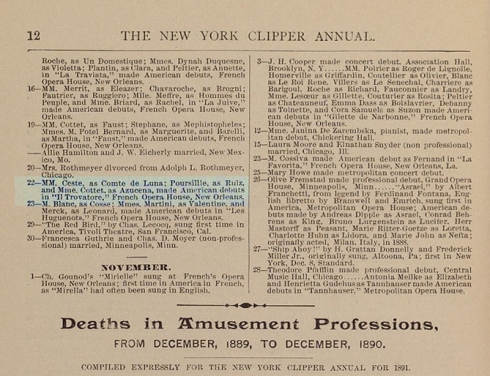
Mr. Ceste and the French Opera House
I believe that the baritone on the poster is Mr. Paul Antoine Ceste who was born in 1860.
In 1890 he was under Durieu Management in New Orleans along with other principal singers. In January 1891 he was in Donizetti's "Lucia di Lammermoor" at the French Opera House in New Orleans. He later returned to New Orleans in 1901 and was under Roverval Management.
The French Opera House, whose real name was the New Orleans Opera House, took one year to build, cost $118,500 to build, and opened on December 1, 1859. It continued performances until it was engulfed by fire on the evening of December 4, 1919. In 1913 it went into receivership and became part of Tulane University. The capacity was 1800 people.
The history of the French Opera House can be seen here.
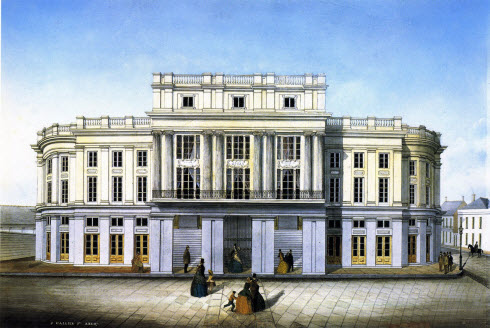
"If I could be instrumental . . ."
Henry Clay, Secretary of State under John Quincy Adams, among other positions.
Monument in N.O. circa 1890
+114
Below is the same view from May of 2004.
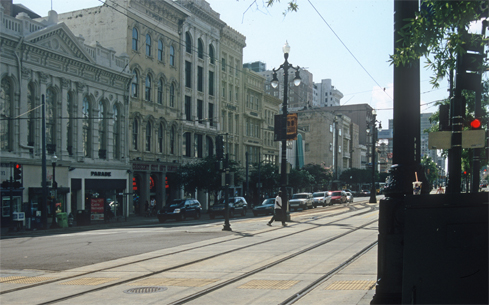
Your Mother Dresses You Funny!
Lucky kid in front of the monument. I suppose he survived peer review and eventually graduated to long pants and a human collar.
Most buildings still there
Though the statue was moved to Lafayette Square.
























On Shorpy:
Today’s Top 5